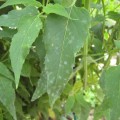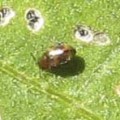Insect-vectored disease spread by thrips. Most common in the southeast
Physical Description
Species & Taxonomy
- Kingdom:
- Phylum:
- Class:
- Order:
- Family:
- Genus Species:
Lifecycle
Plants Affected
- Tomatoes
- Peppers
Plants Unaffected
Geographical Range
Most common in the southeast
Signs & Symptoms
Whole Plant
- black streaks on petioles or stems
- growing tips are usually severely affected
- systemic necrosis
- greatly stunted growth
- plant may exhibit one-sided growth
- in peppers, long necrotic streaks appear on stems extending to the growing tips
Leaves
- upper young leaves of tomatoes turn bronze and develop small dark spots or flecks
- growing tips die out (dieback)
- Peppers:
- virus may cause sudden yelling and browning of young leaves which later become necrotic
- Potatoes:
- broad dark spots and necrotic ringspots, often with yellow-green halos, occur on both upper & lower leaves
- Tomatoes:
- young leaves may show small, dark brown spots and eventually die
- dark brown streaks also appear on stems and leaf petioles
Flowers
Fruit
- ringspots (yellow or brown rings)
- other line patterns of yellow or brown
- in tomatoes, immature fruit have mottled, light green rings with raised centers
- in peppers, fruit formed after infection display large necrotic streaks and spots while younger fruit may be completely necrotic
Roots/Tubers
How to Positively Identify
Differentiate from curly top virus:
- CTV does not cause bronze leaves or small dark spots or flecks on the leaves.
- CTV also does not cause fruit to show
- concentric rings on both green and red tomatoes
Positive identification of the virus requires a lab, but if thrips are present in high numbers, it is likely that one of the viruses (curly top virus or tomato spotted wilt virus) are the culprit
Treatment
Prevention & Control



